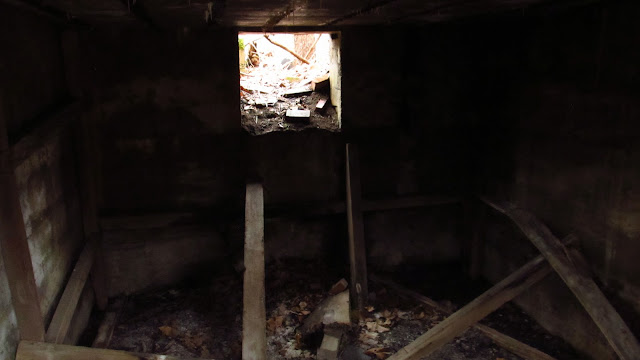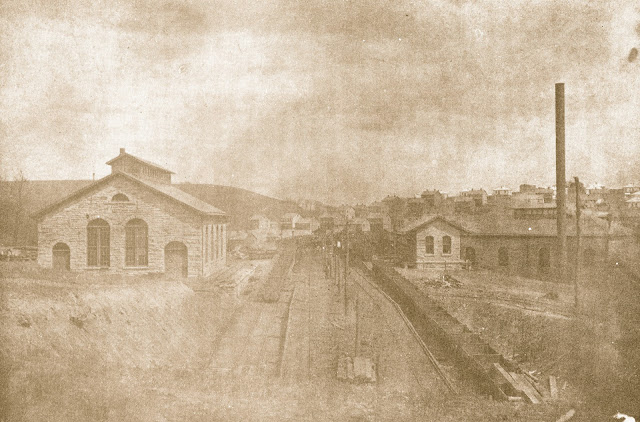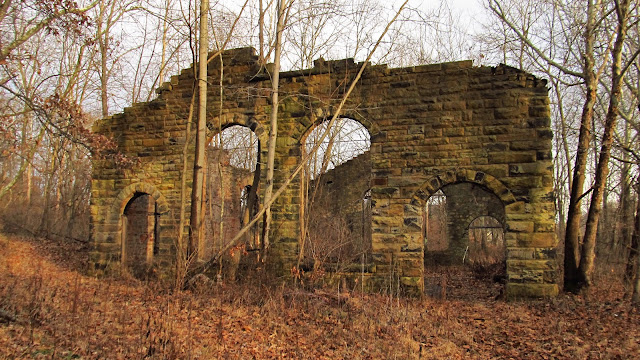The Magee Mine was opened in 1908 by the Westmoreland Coal Company. Magee Mine was named for James Magee, an member of the company's original board of directors. James Magee died in 1878 at the age of 76 at his home in Philadelphia. Prior to Westmoreland Coal, he was one of the corporators in the original Pennsylvania Railroad charter and was on the first board of directors.
 |
| Altoona Evening Mirror November 6, 1878 |
Westmoreland Coal supposedly stopped working the mine in 1954 but I found a snippet in the March 16, 1956 Connellsville Courier listing Magee as being operated by a Clarence B. Pletcher with 7 workers.
 |
| Connellsville Courier March 16, 1956 |
How long Pletcher kept this operation going is uncertain. One thing that is certain is this was a huge mine and it lasted for almost half a century. In 1914 Magee had the largest individual mine output in the entire Ninth Bituminous Coal District (which covered all of Fayette, Westmoreland and Allegheny Counties) with more than 700,000 tons produced that year. They employed 500 men inside the mine alone.
There are many ruins of incredible buildings still existing at the site today. Massive structures of cut sandstone that with roofs could still function today as useful buildings. The stonework is more reminiscent of cathedrals than mine buildings. I have been unable to find mine maps detailing the buildings so I'm going off of information from the National Park Service's Industrial Heritage Project of 1994. Normally I don't base my histories of these sites on this study because I have found too many discrepancies with their information in the past. Now I have no choice because I have nothing else to go on. I did find part of the layout in the 1916 Yukon Sanborn Map but it didn't offer a lot of information. It lists all the buildings as "Engine Houses" which is technically correct because they certainly would have housed engines, but it didn't supply me with the information I was looking for.
 |
| 1916 Sanborn Map |
The first building we came across isn't listed on the Sanborn Map or the 1994 inventory. This is a brick building and is not one of the "great" buildings. However, it exists and is getting documented.
 |
| Approaching the first building. |
 |
| On the back side is this tunnel which goes underneath it but no further. |
 |
| Old piece if rail sticking out of the side. |
 |
| Coal cellar under the building. |
 |
| Side of the building. Still incredible brickwork. |
 |
| Around to the front. |
 |
| You're going to see lots of windows on this post. |
 |
| A look inside through one of the windows. |
 |
| Inside. On the right you can see part of a work bench. This bench ran the length of this wall and the wall behind me. The building was probably a shop of some sort. |
 |
| The brickwork is still very intact. It could really use a roof though. |
 |
| The exterior brick is not wearing as well. |
 |
| Heading off to the great buildings. |
 |
| It doesn't look like much from here but this building is massive. |
 |
| Just look at this stonework! Unlike any mine building. |
 |
| This is just the first room. On the bottom right is the doorway to the next one. |
 |
| Marybeth doing that thing she does when she's in an abandoned building. |
 |
| This building is massive. |
 |
| According to the 1994 survey this is the boiler/powerhouse. |
 |
| Amazing building. |
 |
| Another tunnel in the floor. A pump laying next to it is probably not related to the mine. This has been a dumping ground for a long time. |
 |
| I told you there were a lot of windows in this post. |
 |
| What's left of the roof. |
 |
| A look at the masonry design. Everything about this building is amazing. |
 |
| A final look at the powerhouse. |
 |
| Inside the hoisting house. |
 |
| Off to the sides were these basement areas. |
 |
| Some old knob and tube wiring. |
 |
| The outside of the hoisting house. |
 |
| This is the back side of the power house. It looks like the outside of a cathedral to me. |
 |
| Still some glass in this window. |
 |
| The roof of the power house. The building had a slate roof. There were some intact pieces of roofing slate laying around. |
 |
| This is the next building north of the power house. It is listed as the machine shop. |
 |
| More great stonework. |
 |
| A slot in the stone where the floorboards were show that this building burned up at one time. |
 |
| More burned wood. |
 |
| More views of the machine shop. |
 |
| A view from the side. |
 |
| Not too far from the machine shop are the old slope entrances to the mine. |
 |
| A look at the intact portal. |
 |
| Inside the mine entry. It's sealed about ten feet in. |
 |
| A look outside from the entry. |
 |
| A short distance from the slope entry is what's listed as the cap house. |
 |
| Not much in here. |
 |
| The cap house. |
 |
| I walked back over to the slope entry to look inside the structure on the top. I'm assuming this is the old fan house. |
 |
| Nothing too exciting in here either. |
 |
| This is the back side of the first building we came across. |
 |
| On the other side of the Sewickley Creek you can see the other side of the hoisting house and the old bridge abutments for the Yukon Branch of the Pennsylvania Railroad. |
 |
| Abutments. |
 |
| Westmoreland Coal Co. 1908 plaque. |
 |
| The construction of this building into the hillside is also very interesting. Notice the power house in the back. The only thing missing in this photo is the old iron tipple. |
Here's a few old photo's of the Magee Mine.
 |
| Photo courtesy of Jeffrey Lee |
 |
| Photo Courtesy Jeffrey Lee |
 |
| Photo courtesy Jeffrey Lee |
 |
| Photo courtesy Jeffrey Lee |










































Amazing pictures. Thanks!!! Any speculation on the reason(s) why such massive stone buildings were constructed instead of the more traditional and less expensive brick / wood structures?
ReplyDeleteHey Paul! Thanks. I honestly have no idea. The same company built Export around the same time and all those buildings are brick. I haven't found anything yet about why they built those from stone. Hopefully I'll found something.
DeleteGreat photos Mike. The owner was obviously very proud of his mine and is a testament to the craftsmanship of that era's stonemasons.
ReplyDeleteI live across the Creek from these mines now and I find this so interesting! I've always wanted to go exploring but I haven't yet. Great post!
ReplyDeleteFun fact I live in youkon pa April st.
ReplyDeleteI live on new blacks across from the mine it’s pretty wild all the history
ReplyDeleteI grew up in Yukon. I found a hole when I was younger and dumber. I crawled into it a few feet and it opened up into a huge under ground mine or cavern. It went underneath New Blocks. That was so dumb, but cool to find.
ReplyDeleteCan you comment more on the magee mine and your underground experience?
DeleteI have a lot of friends in Yukon and have seen these buildings quite often but have never visited them , maybe next time !
ReplyDelete